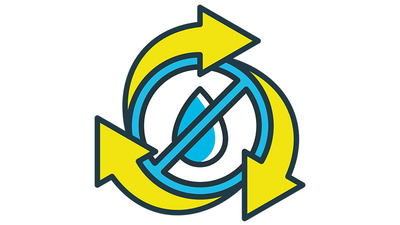Watertight plumbing for efficient and sustainable buildings

The UK’s stock of domestic and commercial buildings is amongst Europe’s most inefficient from a water usage perspective. When we add to this that the UK government placed a ban on hose usage in the summer of 2022, and could be looking to do so in 2023, we need to ensure that we are saving water wherever possible. Yet, every year across the UK’s water network, around 1 trillion litres of water is lost to leaks, with a proportion of this being due to household leaks, which directly goes against our water preservation efforts.
Inefficient water usage in homes – either as a result of leaks or underperforming systems – can lead to higher costs for homeowners, through increased bills and rectifying leak-related damages. Installers can support their customers to avoid this by focusing on the creation of quality, reliable and leak-proof plumbing systems that underpin consistent long-term performance, safety and sustainability.
Let’s look at three solutions from RWC that, on first and second fix installations, can quickly equip a building with a solid layer of protection against water losses and leaks.
Preventing leaks with push-fit pipes, fittings and valves
A significant amount of domestic plumbing leaks occur as a result of failed connections between pipe and fitting. These can happen for a number of reasons, from corrosion and natural wear and tear, through to broken seals and blockages. Equally, poor connections made during installation can accelerate wear and potentially lead to leaks. As a result, the chances of these leaks occurring increases in proportion to the amount of connections that are made.
To reduce the amount of connections within a system – and ultimately reduce the potential for leaks – longer runs of pipe can be used. From an installation perspective, using the right solutions – such as JG Layflat Pipe – is essential to making longer pipe runs a possibility. As a polybutylene coil pipe, JG Layflat Pipe can easily bend around corners to streamline installation and reduce connections. Plus, with its ability to not retain shape memory, it will lay flat and stay flat straight from the coil, making it much easier to handle.
Of course, even where longer runs of pipe can be installed, some connections will still need to be made. To create a leak-proof system, JG Speedfit Twist & Lock® fittings can help installers to maximise every connection. When used together, Speedfit’s Twist & Lock® fittings and Superseal Pipe Inserts create a unique multiseal between the main O-Ring in the push-fit fitting and the insert’s dual O-Rings.
The fitting’s Grip & Seal™ collet with stainless steel teeth allow for an instant, tool and flame free connection that can be installed and demounted in seconds. Additionally, polybutylene plastic is a non-toxic material that prevents corrosion and scale build-up, which provides an extra layer of protection against costly leaks.

Push-fit MPDE fittings for above and below the ground
Even outside of our homes, leaking pipes have the potential to cause damage. Millions of litres of water are lost from the network every day due to leaks, with aging underground pipes and fittings being just one factor.
Issues with underground pipes usually arise as a result of environmental factors that can make it difficult for installers to determine whether a leak-proof connection has been made first time, especially when working with compression fittings. Furthermore, the fittings can become loose over time, which can make a hard-to-fix leak even more troublesome.
To reduce the potential of leaks occurring as a result of compression fittings, alternatives like plastic push-fit MDPE fittings can be used to strengthen every connection that is made. Like all push-fit fittings, a connection is made simply by pushing the pipe into the fitting, which significantly reduces the chance that water will be lost as a result of insufficient connections being made the first time around.
Repairing underground pipes requires extensive amounts of time and labour. In fact, special machinery is required to even identify these problems. Therefore, installers want to ensure that when they are fixing these leaks, they are providing a long-term solution. Push-fit MDPE fittings ensure a reliable and leak-proof seal is made, resulting in stronger and more efficient systems.
Smarter leak detection
As much as we want to implement all the possible measures to prevent leaks from occurring, leaks are unfortunately an inevitability. However, pioneering leak detection technology is currently paving the way to protect us from water loss – and damage – before it becomes a bigger problem. For the vast majority of buildings, leak detection is a manual process, with minor leaks being investigated as they are identified. Unfortunately, some leaks can go unnoticed for months, if not years, at a time – by which point they could have caused significant damage to a property.
A dripping tap can lose up to 1 litre of water in an hour, so imagine how much water is lost to undetected microleaks throughout a building – and the potential damage this could cause. RWC’s Reliance Valves’ MultiSafe Leak Detector Control Valve not only detects these leaks as they occur, but can identify water loss in real-time.
The system works by continuously monitoring water usage throughout the whole plumbing system of a property, enabling leaks to be identified quickly. If a leak is detected, the homeowner is notified via a text or email and, where unusually high water use is detected, an in-built isolation valve is closed to shut off the affected area’s water supply.
The leak detection system prevents leaks from causing avoidable and costly damage, keeps track of the room temperature to recognise where there are risks of pipes freezing, and monitors the humidity inside the pipes to see if there’s a chance for mould to grow.
For an added layer of protection, this system can be combined with the MultiSafe Floor Leak Sensor. As the name suggests, this sensor monitors floors and, like the control valve, sends an alert to the building owner when a wet floor is detected. These sensors are ideal for areas where there is a higher risk of leaks, such as under bathroom and kitchen sinks, or in utility rooms, where leaks can have a more devasting impact.

Stopping leaks for good
By using these innovative solutions from RWC, installers can deliver reliable plumbing and heating systems for customers, minimising the potential for leaks to occur and actively monitoring whole systems to ensure leaks are quickly identified should they occur. By taking preventative steps and ensuring more efficient and sustainable plumbing systems overall, we can begin to reduce the alarming volumes of water lost to leaks every year in the UK.
